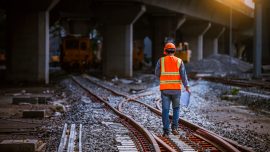Constructing New Tracks? Which Railroad Ties to Use
Whether you are constructing new tracks to replace old and worn tracks, or you’re doing maintenance on current tracks, the most essential part of having a stable track line is what ties you choose to use. There is always a question of what the situation demands, what budget allows for, and what is available, and in what quantities. For this reason, there are several different materials that are used depending on the circumstances for constructing new tracks.
Railroad Ties vs. Railway Ties
The terms railway and railroad are often used interchangeably, but there is actually a distinct difference between the two. A railway is a system of tracks that are used to transport trains, while a railroad is a company that manages and operates a railway system. In other words, a railway is the physical infrastructure, while a railroad is the entity that owns and maintains it.
There are all sorts of different railways in existence, from passenger systems to freight lines, and they can be found all over the world. Railroad ties, also known as crossties or sleepers are the primary lateral support for the rails themselves, anchoring the track and giving it a solid, sound base upon which trains can pass over. (Credit: American Rails).

Wooden Railroad Ties
A variety of wood types were used when creating wooden rail ties such as hardwood and softwood timbers. The main benefit of using wood is that it is relatively inexpensive and can be obtained in greater quantities—which is important when you’re laying down track, the miles add up. However, these benefits have been fading as the years draw on as timber becomes much more difficult to acquire.
The drawback to using wooden ties is that wood is susceptible to rotting due to moisture. Splitting is another issue that compromises the integrity of that particular railway track. Not as common, but dangerous nonetheless, is that wood ties can catch fire.
Overall, wood has a good balance of longevity and cost which makes it a solid option for using in your railway ties. It’s also the most commonly used tie—according to the RTA, which states that roughly 15 million of the 17 million installed ties are wood. That’s over 90%!
Concrete Railroad Ties
Concrete rail ties benefit from being very inexpensive to purchase and can at times be easier to acquire compared to timber. Concrete rail ties are also excellent for carrying heavier weights and are very stable, thus allowing for higher rail speeds.
Steel Railroad Ties
Steel ties have in the past been badly abused due to rapidly changing conditions and technology imposed on them. Many of these old steel ties are actually still faithfully in service today globally which is a testament to steel despite being outdated in design.
Modern steel ties can handle significantly heavier loads and environmental conditions. Creosote-treated wood ties and concrete ties are more impractical to install compared to steel. One of the reasons is that steel can be neatly stacked and transported more easily, it’s also lighter and can be more easily installed onto the existing track ballast than other materials.
Railroad Tie Installation
R&S Track is a premier railroad contractor in the Midwest United States. We have proudly been in business for over 27 years and have had the confidence of numerous companies seeking a variety of solutions including but not limited to:
- Consulting
- Surveying
- Project Design
- Railroad Tie Installation/Track Maintenance
- New Track Construction
We have a 100% track record of customer satisfaction. Don’t believe us? Drop us a line and references will be available on request. Call us now at (402)-564-1801 for any service inquiries or price estimates!





